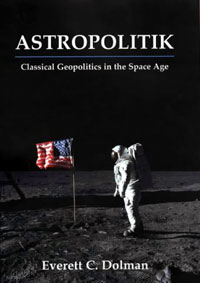Review: Astropolitik: Classical Geopolitics in the Space Ageby Taylor Dinerman
|
| Dolman’s description of the basic militarily relevant facts involved in spacepower is well done and unlikely to be surpassed anytime soon for clarity and comprehensiveness. |
His policy conclusion is that the US should “first declare that it is withdrawing from the current space regime [by which he mostly means the Outer Space Treaty of 1967] and announce that it is establishing a principal of free market sovereignty in space… Second, by using current and near term capacities, the United States should endeavor to seize military control of Low Earth Orbit… Third, a national space coordination agency should be established to define, separate, and coordinate the efforts of commercial, civilian and military space projects.”
While such a policy may seem excessively provocative, it is a logical reaction to a number of current trends, including the EU/Chinese alliance to build the Galileo satellite navigation system and the proposed EU space surveillance system designed to detect, and perhaps eventually target, US stealth satellites. The US has already made it clear that if enemies are using space assets to help kill Americans, either soldiers in the field or civilians at home, those assets will not be safe.
However, Dolman may be expecting too much from his proposed policy. He claims that by rapidly and comprehensibly establishing control of LEO the US would stop a space arms race before it got started, safeguarding the peaceful use of space for all nations. While one wishes this were so, it may not be that easy. The US would have to station inspectors at each and every spaceport or launch facility worldwide. Each payload would have to be inspected before blast off to ensure its peaceful nature. Without such inspections it is impossible beforehand to know just what in being orbited. Weapons or military satellites can be disguised as peaceful scientific satellites. This is not just an issue for the future: any number of satellites today are military reconnaissance satellites in all but name and more are being built and launched every year.
This means that a space arms race is probably inevitable. Indeed, it has already begun. Over the next couple of decades the US will not only have to be ready to use space-based weapons to knock out incoming enemy missiles, warheads and satellites, but it will have to be ready to cope with asymmetric space weapons such as psuedo-debris, swarming mini ASATs, and proximity beam weapons, among others.
| Dolman’s most valuable points concern the lasting negative effect the Outer Space Treaty has had on the commercial development of space. |
If and when the President releases his new military space policy document, it will be interesting to see just how the administration intends to deal with these future threats. An unambiguous goal of military space supremacy such as Professor Dolman desires would seem like the obvious choice, but the White House may choose to wrap this goal in paragraph after paragraph of meaningless verbiage about international cooperation. If so it will be making a mistake.
Dolman’s most valuable points concern the lasting negative effect the Outer Space Treaty has had on the commercial development of space. The treaty includes enough ambiguities concerning potential property claims that only the most reckless investor would venture to build a private facility on the Moon or other “celestial body”. The US has hesitated in the past to question the treaty, fearing that to do so would open it up for wholesale revision in ways that may be detrimental to US interests. As the years pass, however, it becomes harder and harder to see how much worse things could get without the treaty.
A new set of international space rules is inevitable, Dolman has laid out one alternative. Others are free to propose their own ideas, but if they do so by ignoring his work they risk ridicule and irrelevance. For this reason and for many others the author of Astropolitik deserves a vote of thanks from the broader space community.
